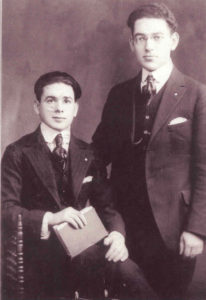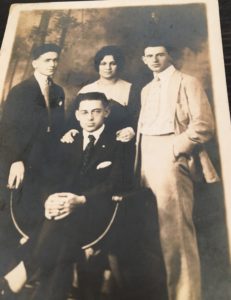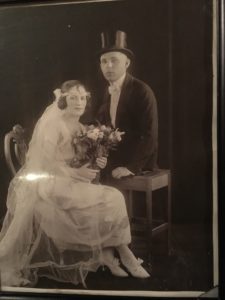(Links to information, photos and descendant charts for Isadore Goldstein and Jeanette Goldstein Eisner are at the bottom of this page)
In about 1973-74 I visited Sol in New York and got information from him about his family: names, locations and so on. I learned that his father was a “tallis macher” (made prayer shawls); documents I found years later describe him as a “weaver,” which makes sense. Sol told me that they were “rich” compared to others in Terespol, but that they still had lice and used an outhouse like everyone else. He started playing cards and smoking cigarettes when he was 15 and at that point, lost any belief in God. When he was about 19 or 20, his father gave him 200 rubles and sent him to his brothers in the US. He surely would have been drafted into the Russian army, otherwise; the Russian Empire had a policy to not draft only sons and oldest sons, which left all the other sons vulnerable to the draft. So off Sol went to the Goldene Medine (the Golden Land), as Eastern European Jews called America.
I had a very difficult time locating Sol’s ship manifest, a typically rich source of information. This was due to the nature of Sol’s name. Because of the way it’s written in English, we’ve always assumed that it was Solomon, or Shlomo in Hebrew. Years ago, Grandpa mentioned that his last name had originally been GOLDSTERN, but his brothers Shimon and Meier changed it to GOLDSTEIN, so he did, too. I searched for his ship manifest under the names Shlomo and Sol/Solomon Goldstein/Goldstern for many years and came up empty. When it came to US-based documents, such as census records, I had better success with “Sol Goldstein.”
Eventually, using JRI-Poland (Jewish Records Indexing-Poland) on JewishGen.org, I’ve found birth registrations for Sol and his siblings and guess what, his name was not “Shlomo” but “SZOJEL,” which, if you account for the Yiddish accent and the Polish spelling, is the name “Saul” – in Hebrew, “Sha’ul.” But because he spelled “Sol,” it looked like it was short for “Solomon.”

I also saw that the name was, indeed Goldstern (in Polish, “Goldsztern”). Interestingly, whenever I search for this name, results with both “Goldsztern” and “Goldstein” (“Goldsztajn”) are returned to me. As far as the search engines are concerned, they are phonetically the same name.
The translation of his birth registration is below:
Akt #8 (Akt means record)
In the city of Terespol, on the 15th of February 1891, at 10 am. The Jew Berko Fayvel Goldstern, weaver, 40 years old, appeared in person in the city of Terespol, in the presence of witnesses, Jews Kopel Monchik, 71 years old, and Haim Yoel Rubinstein, 61 years old, having two retail stores and residing in the city of Terespol, and presented a baby boy to us, announcing that he was born on the 8th of February at 8 am, from his legal spouse Yachvet, born Rozensumen, 40 years old. This baby boy is given a name Shoel at the time of circumcision. This act is announced and read to the witnesses, and then signed by Berko Fayvel Goldstern.
Kopel Monchik
Haim Yoel Rubinstein (signature)
Civilian registry office clerk: Martynova (signature)
You can see that this kind of document provides a lot of information: the location of the birth, the names and ages of the parents and witnesses, the occupation of the father and the witnesses, the date of the birth registration and the date of the birth (eight days earlier, since the name was first announced at the circumcision and only then could be officially registered) and where everyone was living at the time.
Once I had his correct name, I was able to immediately find his ship manifest. On December 21, 1912, he left Antwerp on the SS Kroonland. He was recorded as being 21 years old, single, literate, a painter by occupation, a Russian national of the Hebrew race and his last permanent residence was Brest-Litovsk, Russia. His nearest relative in the country he came from is his father, Berl Goldstein (Berko is a diminutive of Berl) in Brest-Litovsk, Grodno (the province). His final destination is New York, where he arrived on January 2, 1913. He had paid his own passage, was in possession of $25 and was going to join his brother, “Sam” Goldstein at 13 Eldridge Street, NY. He denied being an anarchist or polygamist, was in good health with no deformities, stood 5’4” with a fair complexion, brown hair and blue eyes. Again, his place of birth is listed as Brest, in Russia.
When Sol arrived, he lived with his brothers. Shimon was a house painter, work that Sol had apparently performed in Brest, and Meier was a carpenter. My memory is that he told me one reason he didn’t like painting was that he didn’t like climbing the ladders.

I don’t know if he was active in labor unions, but his politics were on the left, he considered the Yiddish Daily Forward to be a “capitalist rag” and read Morgen Freiheit instead (Morning Freedom).

From photos, it appears that Sol had some kind of social life, though I can’t identify the other people. Since he and Mollie Challov met at a Purim ball in the early spring, he must have known her by the time he registered for the World War I draft in June, 1917 (see below).
According to my sister Frannie Goldstein:
The photo of Molly dressed as a gypsy was given to me by Grandpa. He is the one who told me she was dressed that way when they met at a Purim ball. The photo was unfortunately destroyed in my fire of 1995. He told me that when he saw her across the room he told his friends he was going to marry her. (From an email, November 17, 2017, the 100th anniversary of Sol’s marriage to Mollie).
On June 5, 1917, he registered for the World War I draft. He lived then at 506 Clinton Street, NY, NY, says his birthday was April 21, 1891 and that he was born in Brisk, Grodno, Russia. He also states that he is a “Declarant,” which means that he had filed his “Declaration of Intent” to apply for naturalization (also referred to as “First Papers”). At that time, he was single and unemployed and claims poor vision as a reason to not be drafted.
When he applied for Social Security at age 45, he lived at 2044 75th Street in Brooklyn and worked at the Ramie Hat Company on West 37th Street, NY, NY. Here he gives his birthday as February 21, 1891 and his parents’ names as “Benjamin” Goldstein and Yetta Rosensumen.
On April 26, 1942, at age 51, he registered for the “Old Man’s Draft.” By then he was married to Mary and they lived on 69th Street in Brooklyn. This time he gives his birthday as February 19, 1891 and is working for the Alpine Hat Company on 37th Street, NY, NY.
So we have a number of different birthdays, all in 1891: February 8, February 19, February 21 and April 21. He used the April date on his naturalization documents. And these were all official documents! Like many immigrants, he gave his father a name with which an American official would be familiar, rather than the foreign-sounding “Berl” or “Berko.” Immigrants commonly did this. You can see that one cannot assume too much from all this information.
Sol was naturalized on July 21, 1919, at which time he and his family resided at 244 S Third Street in Brooklyn. His son Isadore had been born a few months earlier on February 28. Interestingly, he had to renounce his allegiance to “the present government of Russia,” as the clerk wrote it. In 1919 it was not clear at all what that actually was, everything was in a state of chaos and flux in the former Empire. It’s always interesting to see how documents and personal writings reflect contemporary reality.
The tragedy of Sol’s life, as far as I know, was the loss of his first wife, Mollie. It was clearly a love match, not approved of by her siblings and derailed at least in part by her intractable depression, which may have started post-partum. After her death, Jeanette (who turned three years old two days after her mother’s funeral) was sent to live with the family of Mollie’s sister, Ida Challov Zlotnick (“Tante Chaike”). Isadore and his father lived with Sol’s brother’s Shimon and Meier, in turn. On November 20 of the same year, Sol married Mary Katz Garfinkle, a widow with a five-year old daughter named Annette.
The story I heard was that Mary and her husband Harry Garfinkle were also a love match. He had a “sour stomach” and when their daughter Annette was less than two years old, died of stomach cancer at the age of 28.

Sol’s daughter Jeanette described Sol to me as being very smart and self-educated through reading. I remember seeing a set of Jules Verne books in Yiddish in his closet. She herself did not see a photo of her mother until Ida and her daughter Belle gave her some when she was already an adult.
In later life, Sol and Mary bought a co-op apartment in Brooklyn on Neptune Avenue. Construction was drawn-out with many delays and I remember my father and Sol discussing this matter with some annoyance. Eventually it was completed, they moved in and lived there till they died. This was Trump Village, developed by Fred Trump.
After retirement and while living in Trump Village, Sol was part of the “Golden Age Club” there. One thing he did was set up the chairs for daily minyan. Apparently late in life he found some value in returning to his religious roots, at least for the social aspect if nothing else. When he died, I was given his siddur, from Israel and with an olive wood cover and is entirely in Hebrew.
ISADORE J GOLDSTEIN INFORMATION & PHOTOS
JEANETTE GOLDSTEIN EISNER INFORMATION & PHOTOS